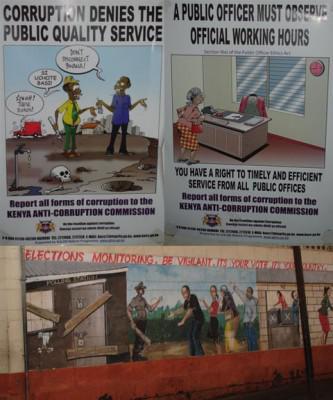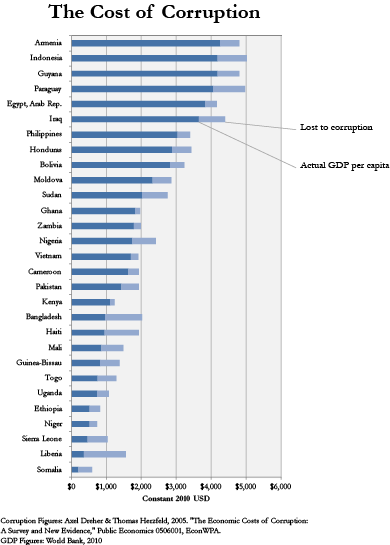
Anti-Corruption posters in Kenya. (Photo: Staff)
The World Bank estimates that corruption may cost the world economy about a $1 trillion a year. In more practical terms, as the chart below shows, corruption in some countries is robbing the world’s poorest people of up to three quarters of their economic potential. This means less money to feed their families, send their children to school, buy medicine, or start a business with.
A taboo subject for decades, corruption is now recognized as one of the biggest obstacles to both economic development and the growth of democracy. Today the global development community will be focusing its attention on this vital issue for International Anti-Corruption Day.

The cost of corruption.
To fight against corruption, it is important to first understand what “corruption” actually means. Corruption is notoriously hard to measure, since it takes place in the shadows, but it can also be surprisingly difficult to define. Most people would agree that a police officer accepting a bribe to let a criminal go free is corrupt (and deplorable). But corruption in government procurements can also cost countries – even developed ones – billions of dollars a year. Corruption in the private sector distorts competition and harms consumers, shareholders, and entrepreneurs trying to start new businesses. And political corruption skews elections and undermines government policy-making all over the world. To make things even more confusing, behavior that would be considered corrupt in one country may be perfectly legal, or at least socially acceptable, in another.
Because of this complexity – or perhaps simply because it is more visible – discussions about corruption tend to focus on so-called “petty” corruption, like traffic police who shake down motorists, or building inspectors who take bribes to certify faulty structures. “Petty” is a misnomer, of course: this kind of corruption impedes growth all over the world – not to mention the human costs when, for example, those faulty structures fall down in an earthquake. But this kind of corruption can still be seen as a symptom of a larger disease. When people at the bottom are openly taking bribes, one can expect to find even more brazen corruption at the top.
Like corruption itself, the battle against corruption takes many forms, from simple posters (like the ones above) to complex international agreements aimed at curbing bribe-paying by multinational corporations. However, too many of these efforts focus on exposing and punishing corruption after the fact, rather than fighting the underlying, structural causes of corruption. All of the kinds of corruption described above are rooted in perverse incentives and flawed institutions, institutions which it will take committed local stakeholders to truly improve. As CIPE regional director Abdu Alkebsi writes at RealClearWorld today, focusing on Iraq, “It is true that you cannot stop wolves from eating sheep by shaming, punishing, or educating them. Through comprehensive institutional reform, however, Iraqi society can build the ‘fences’ necessary to keep its sheep safe.”
That’s why CIPE works with its local partners around the world to help civil society develop its voice and use that voice to combat the structural roots of corruption, such as bad regulatory policies, lack of accountability, and weak enforcement of existing rules.
In Thailand, for example, CIPE works with its partners to encourage the private sector to take collective action against corruption, helping to attack the problem from the “supply side.” CIPE also supports the UN Global Compact, which encourages important initiatives for businesses to help fight corruption.
On the “demand” side, CIPE has worked with Transparency International and local partner organizations to encourage the adoption of APEC’s procurement standards, bringing much-needed transparency to the $10 trillion government procurement sector not only in Asia, but also in Mexico, Peru, and other countries.
The fact that the development community is finally recognizing corruption as one of the biggest roadblocks to development is heartening. But in the end, it is only the people and organizations in developing countries that can truly transform their societies and institutions and excise the cancer of corruption.
For an in-depth look at the toll that abuse of power, neglect, and bribery have taken on economic growth and development in Yemen, watch the trailer for the CIPE-sponsored documentary Destructive Beast. You can also find out more about CIPE’s anti-corruption programs at our main Web site.

